The highly versatile Lanber Model 2097EST Sporting
by Damien Edwards
Hunter 12
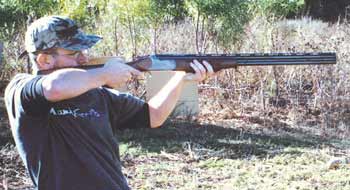
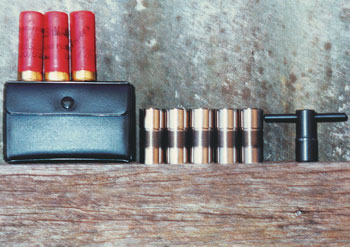
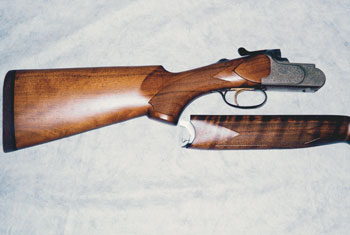 The Lanber line of shotguns have recently been established as being some of the most economical and functional guns in their class. In the time they have been available on the Australian market they have been publicised as being hardy durable guns of good quality. There are currently more than a dozen different models available, which run the gamut of what clay shooters and hunters look for when selecting a gun for their specific application.
The Lanber line of shotguns have recently been established as being some of the most economical and functional guns in their class. In the time they have been available on the Australian market they have been publicised as being hardy durable guns of good quality. There are currently more than a dozen different models available, which run the gamut of what clay shooters and hunters look for when selecting a gun for their specific application.
The Model 2089E Universal Competition and 2099E Trap are truly pinnacles of their class and are more than capable of competing with other well-established makes, such as Beretta, Miroku and Laurona, when it comes to serious competition work. At the other end of the scale they produce guns that will offer the occasional clay shooter, hunter or man on the land with years of trouble-free service.
It is in this myriad of shotguns that we find the highly versatile Model 2097EST Sporter. This particular model is aimed at the shooter who wishes to hunt rabbits and ducks, but also uses their firearm for competitive shooting clays. It is not an expensive gun, but it does pay to shop around as prices can vary drastically from shop to shop. Most are currently retailing for about $1300-$1400.
Barrels
All Lanbers are made in Zaldibar, Spain and proofed at Eibar, Spain. Proof houses first appeared in Eibar in 1844. At that time, proof was on a voluntary basis and was not compulsory under law until 1923.
The barrels of the 2097 are of a very high standard. They show no sign of any excess solder residue along the ventilated top or side ribs. The blueing is rich, deep and lustrous. This has been a characteristic of all the Lanbers I have seen and appears to be a common style in Spain. Zabala make their guns there and share this trait; nevertheless, I am not complaining and with no visible machine marks, the barrels are faultless. They are stamped as being 1564 grams, or just more than a kilo and a half. I weighed them myself with the fore-end off and they were spot on. The Lanber quality control staff must be on the ball.
Earlier, I alluded to the 2097’s versatility. You can order this gun with either two and three-quarter or three-inch chambers and 28- or 30-inch barrels. It is also available in either left- or right-hand configuration. This is a great feature as it permits the purchaser to order a gun to taste. A sort of semi-custom feature without custom gun expense. I chose the three-inch, 30-inch right-hand option. Both barrels carry proof marks stating they are proofed to a pressure of 1370-bar. Older Lanbers were proofed to only 1200-bar as are modern Zabala guns. This makes the 2097 suited to the most powerful magnum lead loads.
The gun is also proofed for steel shot, although Lanber advises against using these cartridges with anything tighter that half or modified choke. The top rib is wide, 12mm, and has a white-sight at the muzzle. Red is also available. It features a type of crosshatched filing with a slightly deeper longitudinal section in the middle, which helps with instinctive target alignment as it is a natural centre for the eye. This is obviously influenced by clay target shooters. It is strongly visible and is a style I personally have a preference for.
Five chokes are supplied with this model, which greatly aids in its adaptation at traps or in the field. Each of the five is 47mm in length and features a long thread section. The top of the chokes, the part that lies flush with the muzzle, has notches cut into it - the more notches the more open the choke. They are cylinder, improved cylinder, modified, improved modified and full and measured .006, .011, .022, .033, and .040. This is a useful spectrum and permits use on clays, quail, ducks, geese, foxes and hare.
The chokes come in a handy closeable container that surrounds three chokes and their wrench in foam while the other two are in the gun. These chokes are made of hardened molybdenum alloy steel. They are not about to wear out any time soon and their engineering uniformity guarantees correct pattern density. This little case is good protection and is no more obtrusive than a pack of cigarettes. The system of choke interchangeability is more than 120 years old and is much better and more cost-effective than changing barrels or buying a second gun.
Those of us who use this system must be aware that it is imperative to also clean the chokes after shooting - to promote their serviceability. Special attention should be paid to the threads on them and to the corresponding mating surface inside the muzzle. The ejector timing was excellent, throwing empties out with authority. The ejector is split and in the event only one barrel is fired, when the gun is broken, only the spent shellcase is ejected. The unfired shell remains.
Receiver
The action is a boxlock and features truly eye-catching engraving, comprising flowers, swirls and spiral designs. This style was very popular in England in the period between the two world wars. The engraving is carried onto the underside of the receiver and also the triggerguard. I’ve seen engraving not half as elaborate on guns costing more than twice as much.
Metal-to-metal fit is superb and the wood-to-metal fit is nice and tight. The single trigger is golden and smooth without grooves. Only the models 2081 and 2084 have double triggers. The safety is manual and located on the top tang under the thumb, as it should be. It works in the conventional manner. Rearwards is ‘safe’, at which point a large S for safe can be clearly seen, and when the trigger moves forwards to cover the S, this indicates the ‘fire’ position.
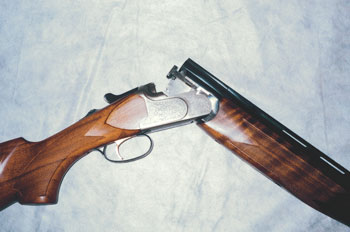
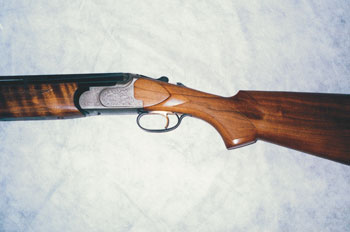
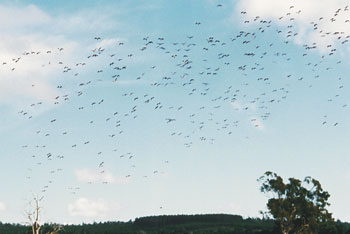 The trigger is selective. This is achieved via a button incorporated into the sliding tang safety. Slide it left and it exposes a single dot indicating you are about to fire the top barrel. Sliding it right exposes two dots for the bottom barrel. One can either slide this barrel selector manually between shots or select the barrel you wish to fire first, and then pull the trigger twice. The gun is cocked in this fashion by the recoil generated by the first exploded shell, no matter which barrel was the first to be shot. This design allows both barrels to be fired in very rapid succession and is governed only by the shooter’s reflexes. Very handy for fast close-in clay shooting.
The trigger is selective. This is achieved via a button incorporated into the sliding tang safety. Slide it left and it exposes a single dot indicating you are about to fire the top barrel. Sliding it right exposes two dots for the bottom barrel. One can either slide this barrel selector manually between shots or select the barrel you wish to fire first, and then pull the trigger twice. The gun is cocked in this fashion by the recoil generated by the first exploded shell, no matter which barrel was the first to be shot. This design allows both barrels to be fired in very rapid succession and is governed only by the shooter’s reflexes. Very handy for fast close-in clay shooting.
I found the trigger rather light but haven’t experienced any problems with it. The cocking mechanism on the bottom of the action is wide and robust and the action depth is approximately 64mm, not too deep. There are recesses on the inside of both sides of the receiver that aid in the sturdy lockup of the barrels. There is enough metal to assure strength yet the gun is not too heavy. The gun is broken by means of the usual top lever. The internal tolerances of the receiver frame and the breech end of the barrels give a very firm lockup. The action is still quite tight, but will wear-in as the gun gets more use. There is a very resounding ‘snap’ as the ejectors do their work when the gun is broken. As with most doubles, the top lever will eventually wear-in and centre itself. Don’t be alarmed if it is slightly off to the right. All in all, the machining of the receiver was very even and completely free of rough spots. It is certainly a strong design and the silver nitrided action with its lovely engraving simply adds to the appeal.
Woodwork
The stock of the 2097 appealed to me a great deal. It is made of select European walnut and exhibited a reasonable figure of grain. The chequering is made by machine and is impressed, not cut. However, it covers both sides of the pistol grip and is very generous. The length of pull is 36.7cm or 14½ inches. The drop at comb is 35mm or one and a half inches and the drop at heel measured out as being 55mm or two and a half inches. I am a tall man; I stand at 6'1" and have broad shoulders, long arms and big hands. These stock dimensions suit me to a tee and the generous amount of chequering on the pistol grip combined with the wide clearance in the triggerguard is very comfortable for my large hand. The fore-end is large too, and features a stylish schnable tip. This feature is one of my personal favourites and I feel any firearm with this inclusion lends itself to quality. The old Brno No. 2 and my own Savage Model 1899 hammerless lever action rifle both share this popular fore-end style and for me it offered immediate appeal.
The fore-end is attached to the barrel by means of a latch, which is called the Deeley or Greener Improved fore-end. It features a recess that permits the finger to slip in and pull down on the latch. This in turn releases a hook inside the fore-end and allows it to come free of the barrel. Simple and straightforward.
Just rearwards of the receiver, both sides of the stock feature raised panels that taper rearwards; once again, this is reminiscent of the 1899 Savage and a good many other double guns - both over and under and side by side. The stock is obviously sporter in design and is shod with a rubber recoil pad with a black spacer. The top of it is slightly rounded down so as to prevent it catching on clothing as the gun is being mounted.
The pad also provides a non-slip surface. Total overall length of the assembled gun is 46½ inches or 118cm. Don’t forget this is the 30-inch barrel model; a 28-inch barrel model will, of course, come up five centimetres less. It weighs three and a half kilos or just less than eight pounds.
In the field
The Lanber is a true delight to shoot. At my local gun club using the more open chokes I experienced a high success rate on clays with several runs of consecutive first-shot breaks. Ammunition used was Winchester AA 32-gram loads of number seven and a half shot. The clays weren’t just smashed, they were powdered! The gun swings effortlessly and comes up to the shoulder instinctively. Heavier charges of shot were used in the form of 36-gram and 48-gram Winchester Double X three-inch magnum loads. I wanted to ascertain how the Lanber recoiled with such cartridges and although the recoil was indeed stouter, I certainly wouldn’t call it uncomfortable.
On the vast open swamps and waterways of central Queensland and the top end, the trend seems to be toward slightly heavier charges of shot with Winchester Bushman 34-gram loads of No. 4 shot being highly popular. It doesn’t take much imagination to foresee limits of water whistle duck, grass whistle duck and our old favourite, the magpie goose, falling under the fire of sportsmen and women armed with one of these 2097s. It is when hunting these larger, heavier species of waterfowl at longer range that the interchangeable chokes teamed with the three-inch magnums will really bring the Lanber into its own.
I’m very proud to be a Lanber owner. I’ve always had an appreciation for fine firearms and thus have never complained about paying extra for quality. With the 2097 there are no complaints. The quality is built into it, as evident by its flawless barrels, beautiful engraving and fine lines. It epitomises all that is elegant, stylish and tasteful in gunning without the expense of more ‘illustrious’ makes. If you’re searching for a decent entry-level trap gun that will allow you to be competitive and still permit you to get among the ducks and rabbits, you couldn’t do much better than the Lanber Model 2097EST Sporting. It is a truly versatile gun.
